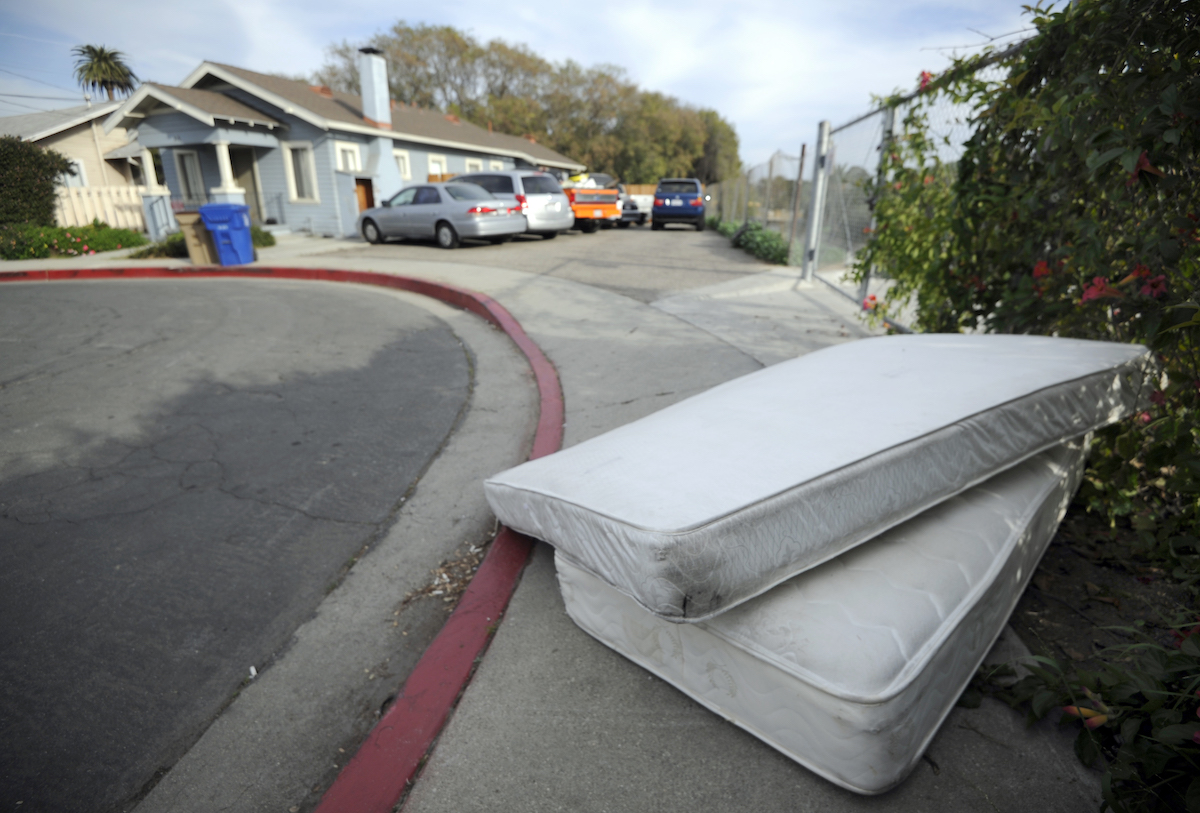Santa Barbara Goes to the Mattresses
County Supervisors Vote to Expand Residents’ Mattress-Recycling Options in Effort to Curb Illegal Sidewalk Dumping

If all the old, discarded mattresses and box springs collected last year at MarBorg’s disposal facility on Quarantina Street on Santa Barbara’s industrial lower Eastside were lined up end-to-end, they’d extend nine miles out. As it is, these were collected and sent off to a recycling facility in Santa Maria, where the wood and box springs are separated out, thus keeping 7,027 used mattresses — 195 tons’ worth — out of the county’s landfill facility at Tajiguas. (That’s a much bigger number, by the way, than the 1,267 mattresses reported collected the prior year.) About 75 percent of the material extracted from these old mattresses can actually be recycled. The wood is mulched, the springs are sold as scrap metal, and some of the foam and quilt toppers go into making carpets.
“That’s very powerful,” said MarBorg’s Brian Borgatello, whose family runs the only mattress-recycling facility on the South Coast. It’s also free of charge to county residents just so long as you don’t try to recycle more than four mattresses a day.
The county supervisors voted this Tuesday to approve a new contract with the Mattress Recycling Council that will expand residents’ mattress-recycling options, opening a facility — known in the parlance of the Mattress Council as “Bye-Bye Mattress” outposts — in the Santa Ynez Valley as well. Under the terms of the county’s new contract with the Mattress Council, the county will now be paid $2.25 per mattress. That’s new. For the past 10 years, only the direct service providers — such as MarBorg and Cleaner Earth, which serves Santa Maria residents — got paid that amount.
Mattress recycling was mandated by a state law passed 10 years ago to put the brakes on sidewalk dumping and other forms of guerrilla trash disposal by requiring that mattress manufacturers provide cradle-to-grave product responsibility. Nationally, about 22 million mattresses are getting dumped into landfills a year, according to the Mattress Council, taking up increasingly scarce landfill space.
Sign up for Indy Today to receive fresh news from Independent.com, in your inbox, every morning.
All this recycling effort is subsidized by proceeds from the $10 surcharge the State of California imposes on each mattress sold. But even with free recycling, enough mattresses still end up on the street that the County of Santa Barbara has designated full-time employees to track illegal mattress dumping. In fact, the illegal disposal of old mattresses and box springs emerged as a campaign issue during an especially low-key Santa Barbara City Council race about 10 years ago.
Borgatello said he’s not making money off the program — which requires that the mattresses be kept clean and dry and stored separately — but that he and others in his line of work are keeping the bulky, space-consuming items out of a landfill with a limited lifespan.
Not all mattresses, however, will be accepted for recycling. Those showing signs of bedbug infestation — the rusty fecal smear is a tip — are rejected, as are those that are otherwise soaking wet, mangled, or showing signs of human fecal contamination. The Mattress Council also cautions members of the public from showing up with old pillows, mattress covers, sleeping bags, water beds, or baby bassinets and expecting free recycling. Those are not covered.
Borgatello said many of the mattresses collected come from roll-off boxes. “But we get a lot during Isla Vista move-out day at the end of the term,” he said. “That’s a major source.”



